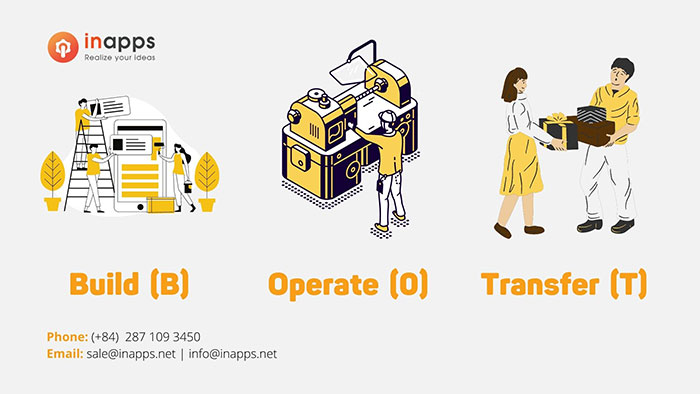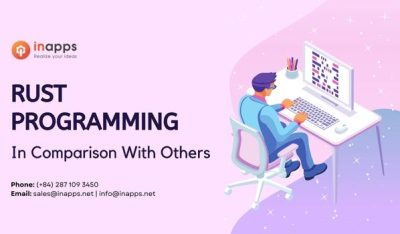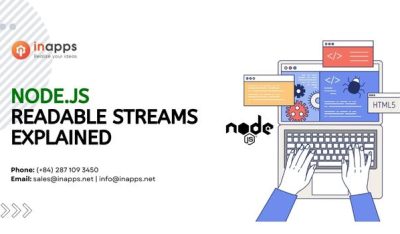- Home
- >
- Software Development
- >
- Build Operate and Transfer Model In Software Development | Meaning, Phases, Benefits
Choosing IT software outsourcing as a strategy for tech consulting firms, service providers, agencies, and so on is a cost-cutting strategy that does not compromise quality. Unfortunately, there is still a caveat in that finding a dependable, adaptable, and flexible outsourcing partner – one who fits pre-existing processes without overlapping – is extremely difficult.
As a result, some businesses are looking to implement an efficient and straightforward Build Operate and Transfer model in software development outsourcing. This gives partners the ability to manage and build an outsourced unit.

What is build-operate-transfer?
Build Operate Transfer Model In Software Development Outsourcing
What is Build Operate Transfer in software development?
The Build Operate Transfer (BOT) model in software outsourcing is a contractual relationship in which an organization hires a service provider to set up, optimize, and run an IT or business process with the contractually stipulated intent of transferring the function to the organization as a captive center. BOT, as a hybrid model, combines elements of the “build” option (i.e., “insourcing” or captive center) and the “buy” option (i.e., outsourcing).
Build operate and transfer examples in software development outsourcing
The software outsourcing build-operate-transfer (BOT) model is frequently associated with financing projects, private-public partnerships, and infrastructure. However, in this case, we will concentrate on the fact that it is an outsourcing model.
More common outsourcing models, such as co-sourcing or staff leasing, comprehensive sourcing, and facilities outsourcing, are frequently used as a starting point when launching offshore operations. When the company is ready to take over and fully operate the entity that the outsourcing partner previously managed, it may do so at any time after making the decision. The entire operation will be transferred from the outsourcing partner to the owner company when that time comes.
Note when using Build Operate and Transfer model in software development
Companies that prefer to use the build-operate-transfer model in software development outsourcing frequently have a vision or a plan to operate and own their organization, commonly located in a foreign country. However, this implies that they want to strengthen their capabilities before tackling or mitigating newbies’ common risks during the start-up stage. As a result, such a company must enter into a contract with a potential outsourcing company to develop a shared service or offshore delivery company that can operate for a set period.
Before taking complete control of the team, the software outsourcing build operate transfer model frequently assists until the unit is adapted to the company’s methodologies, processes, and tools.
Phases of The Build Operate and Transfer Model in Software Development
In software development outsourcing, the build-operate-transfer model is divided into three phases: Build, Operate, and Transfer. These stages are completed as the unit evolves and grows in preparation for the company’s takeover.
1/ Build:
There is much activity in this phase because the operation unit is being set up. This includes everything from building selection to setting up and installing infrastructures such as IT devices, the Internet, and computers, among other things. This is also when staff is hired, and the legal framework and administration are established.
The company should have specified the desired offshore country, among other things, by this point.
2/ Operate:
This is where project management takes place during the operating phase. This includes project or product development, management, enhancements, maintenance, and product support.
Furthermore, there is a lot of team coaching and personnel development until the team reaches the ideal level of business maturity and technical capacity. Most of the time, there is a set amount of time that this phase lasts.
3/ Transfer:
The final transfer of project ownership from the outsourcing partner to the client occurs during the transfer phase. However, this happens only when the client declares that it is fully ready to control the projector when the contract expires. When this occurs, the client acquires a new offshore subsidiary, transfers assets, and performs handover operations.
The transfer phase may occur earlier than the contractual period if the company determines that it is ready and thus purchases the entire operation. However, there are some cases where the phase occurs later for various reasons.
Build-Operate-Transfer Software Development Outsourcing: Reasons To Consider
With so many options for outsourcing available to customers, here are a few reasons why the build-operate-transfer model in software development outsourcing is ideal.
1/ Saves money and time
As a business owner, time is money. Sometimes you forget to value your own time, which means that every hour you put in at work has value, and that value is monetary. Simply put, it may take you 8 hours to understand and figure out how things work, whereas someone else can be paid to finish the job in an hour. By doing so, you are saving money because the time you would have spent figuring things out can now be put into your business and used to do something productive.
It may be a mental shift, but it is critical to recognize it. The build-operate-transfer model is a rather clever method of outsourcing that effectively saves time and money by providing more short- and long-term cost savings. This, in turn, helps to reduce the overall cost over time.
2/ No man is alone
Despite how cool the hashtag #superCEO sounds, it is simply not possible. The truth is that CEOs cannot do it all. It is simply impossible to be in multiple places at once and do everything for everyone, all of the time.
Perhaps taking on a lot is still possible, but at the end of the day, there are some things that even the super CEO wants to put off or dislikes doing. When it comes to that, it is best to outsource it. When work is outsourced, time is saved, allowing more time to be spent on income-generating activities or other “everything” that needs to be done.
3/ Lowers stress levels
There are many things that entrepreneurs or CEOs must do for their businesses. As a result, stress levels rise. This refers to point #2, which states that even the most potent CEOs require assistance.
Entrepreneurs or CEOs can have some magic for their business by using the software outsourcing build operate transfer model. As a helping hand is provided for the company, stress levels are reduced. As a result, business objectives are met on time and, in many cases, within budget.
Although outsourcing can be stressful at first, stress levels decrease once a routine or habit is established.
4/ Experienced partners
Many businesses or entrepreneurs prefer to use the software outsourcing build-operate transfer model because it allows them to reap the benefits of having an experienced outsourcing partner such as developers on hand. These professional partners can manage, set up, and administer operations for them, reducing risks – especially when entering a new country or testing out a new market. It is a win-win situation.
Build Operate Transfer BOT Model Benefits
A well-executed build-operate-transfer in software development outsourcing model has several advantages. There are still some points to consider, but the benefits outweigh the challenges for most people.
1/ Helps put the product on the market faster
This is a common advantage of the BOT model because it allows resources in a different time zone or location. The model aids in bringing the product to market faster because it appears to have a nearly 24-hour process cycle – this also depends on the difference. It does, however, ensure that development is continuous and that no time in the day is wasted.
2/Cost-saving and profitable
Businesses are more concerned with saving money than spending it. This is why the software outsourcing build-operate transfer model frequently emphasizes how it helps cut costs in any way it can.
In most cases, the model saves up to 60% of the usual cost because the project and team are owned, managed, and operated by an offshore group. The money saved can then be used to help enrich and develop the company’s employees. It could also be used as an investment or hire more skilled workers.
3/ Minimizing risks
One of the other advantages of the software outsourcing BOT model is that it reduces risks. Sure, there are always risks. Because every country has problems, the BOT model helps reduce the risk of being in a different country by potentially diversifying investment for its investors.
Risk is also reduced because, more often than not, the outsourcing partner is already familiar with the country’s conditions in which it operates. As a result, they are frequently prepared for potential problems that may arise during the time it takes to set up the team.
4/ Logistics
The entrepreneur can establish a subsidiary without worrying about logistics or establishing an offshore office. This includes the employees’ team, who are all under the control of the outsourcing partner. All of this is accomplished with minimal effort and a small initial investment.
Furthermore, the partner makes use of local geographical knowledge. This is highly beneficial when establishing an offshore subsidiary. The outsourcing partners often have expertise and relationships that other companies do not have. Companies can save time and money by partnering with local businesses to learn the intricacies of the area, especially when it comes to hiring, finding office space, and other tasks.
5/ Ready resources
When the transfer begins, the team of resources has already been trained and adapted. They’re all set to go. The company can time the resources and eventually transfer once the resources are ready – which is frequently based on meeting goals and quality metrics.
6/ Rapid scaling
Companies using the BOT model can rapidly scale their operations by offering a broader range of service offerings, filling gaps in the business model. This is primarily due to the free time gained by the company as the outsource partner handles other matters, leaving more room to brainstorm for rapid scaling.
7/ New technologies
Companies with an already knowledgeable team can easily ramp up or ramp down quickly and introduce newer technologies. Having new technologies to play with is also an added benefit that frequently engages and retains team members.
A larger idea pool with experienced resources can help boost development in the right direction without the CEO or company exploring and learning about new things manually. Instead, they can receive feedback or ideas or allow the team to grow as needed – if they are given enough leeway.
Having said that, some businesses still face difficulties in promoting the concept of having corporate subsidiaries outside of their corporate headquarters. On the other hand, the build-operate-transfer model enables these businesses to reach out to outsourcing vendors and establish an offshore team and the environment. They can take control and ownership of the setup over time.
Companies can get the most out of their outsourcing partners by following this scenario. At the same time, they have a strategy to keep business operations and knowledge in-house, as if they were part of the same company. With more time, the company can develop and improve its core business. The outsourcing partner can oversee the development and the offshore operation and ensure that things are completed before transferring ownership.
Let’s create the next big thing together!
Coming together is a beginning. Keeping together is progress. Working together is success.




















